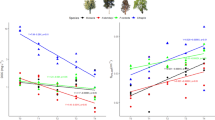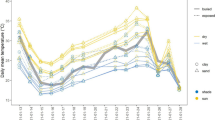Abstract
Thompson Run, a headwater stream in central Pennsylvania (U.S.A.), supports an impaired macroinvertebrate community downstream of the outlet of a detention pond that receives urban runoff. To determine if toxicity from the metals or other pollutants in urban runoff contributed to impairment, we exposed adult, male Gammarus minus to urban runoff during a 42-day in situ bioassay that included 12 rain events. Test animals were collected from a site upstream of the detention pond outlet using two methods: precopula pair separation and sieving. Water quality, temperature and tissue metal concentrations were measured during the bioassay. The survival of precopula G. minus was lower (p=0.048) at a site downstream of the detention pond outlet compared to a site upstream of it, but the survival of sieved G. minus was not different between sites (p=0.803). Large hourly increases in temperature (up to 6.6 °C) and major reductions in water quality including order of magnitude increases in suspended materials (measured as turbidity) and the concentrations of copper, zinc and lead occurred downstream of the detention pond outlet during stormflow (i.e. following rain events). In contrast, changes in temperature and water quality were minor upstream of the pond outlet throughout the bioassay. Copper and cadmium concentrations in leaf samples and copper, zinc and lead concentrations in G. minus samples were significantly higher downstream of the pond outlet than they were upstream of it. Despite harsh conditions downstream of the pond outlet (i.e. metal contamination, inputs of suspended materials and rapid temperature increases), the in situ bioassay did not convincingly demonstrate that urban runoff was toxic to adult, male G. minus.
Similar content being viewed by others
References
Bascombe, A. D., J. B. Ellis, D. M. Revitt & R. B. E. Shutes, 1990. The development of ecotoxicological criteria in urban catchments. Wat. Sci. Technol. 22: 173–179.
Buikema, A. L., Jr & E. F. Benfield, 1979. Use of macroinvertebrate life history information in toxicity tests. J. Fish Res. Bd Can. 36: 321–328.
Clements, W. H., D. S. Cherry & J. Cairns, Jr, 1988. Impact of heavy metals on insect communities in streams: a comparison of observational and experimental results. Can. J. Fish. aquat. Sci. 45: 2017–2025.
Dupuis, T. V., & N. P. Kobriger, 1985. Effects of highway runoff on receiving waters, volume 4: procedural guidelines for environmental assessments. Publication No. FHWA/RD-84/065. Federal Highway Administration, McLean, Virginia.
Field, R. & R. E. Pitt, 1990. Urban storm-induced discharge impacts: U.S. Environmental Protection Agency research program review. Wat. Sci. Technol. 22: 1–7.
Galli, F. J., 1988. A limnological study of an urban stormwater management pond and stream ecosystem. M.S. Thesis, George Mason University, Fairfax, Virginia.
Gammeter, S., 1995. Disturbance effects in small streams due to urban drainage. Bull. N. am. Benthol. Soc. 12: 110.
Garie, H. L. & A. McIntosh, 1986. Distribution of benthic macroinvertebrates in a stream exposed to urban runoff. Wat. Resour. Bull. 22: 447–455.
Gee, J. H. R., 1988. Population dynamics and morphometrics of Gammarus pulex L.: evidence of seasonal food limitation in a freshwater detritivore. Freshwat. Biol. 19: 333–343.
Hollander, M. & D. A. Wolfe, 1973. Nonparametric Statistical Methods. Wiley & Sons, New York.
Jones, R. C., & C. C. Clark, 1987. Impact of watershed urbanization on stream insect communities. Wat. Resour. Bull. 23: 1047–1055.
Kastrinos, J. R., 1985. Seasonal, hydrogeologic and land-use controls on the concentrations of nitrates and other pollutants in carbonate waters. M.S. Thesis, The Pennsylvania State University, University Park, Pennsylvania.
Klein, R. D., 1979. Urbanization and stream quality impairment. Wat. Resour. Bull. 15: 948–963.
Leland, H. V., S. V. Fend, T. L. Dudley & J. L. Carter, 1989. Effects of copper on species composition of benthic insects in a Sierra Nevada, California, stream. Freshwat. Biol. 21: 163–179.
Lenat, D. R., & J. K. Crawford, 1994. Effects of land use on water quality and aquatic biota of three North Carolina Piedmont streams. Hydrobiologia 294: 185–199.
Lenat, D. R., D. L. Penrose & K. W. Eagleson, 1979. Biological evaluation of non-point source pollutants in North Carolina streams and rivers. Biological Series No. 102. Department of Natural Resources and Community Development, Raleigh, North Carolina.
Lieb, D. A., 1998. The effects of urban runoff on the benthic macroinvertebrate community of Thompson Run, Centre County, Pennsylvania. M.S. Thesis, The Pennsylvania State University, University Park, Pennsylvania.
Lieb, D. A. & R. F. Carline, 1999. The effects of urban runoff from a detention pond on the macroinvertebrate community of a headwater stream in central Pennsylvania. J. PA Acad. Sci. 73: 99–105.
Lopes, T. J., & K. D. Fossum, 1995. Selected chemical characteristics and acute toxicity of urban stormwater, streamflow and bed material, Maricopa County, Arizona. Water Resources Investigations Report 95–4074. U.S. Geological Survey, Tucson, Arizona.
Maltby, L. & C. Naylor, 1990. Preliminary observations on the ecological relevance of the Gammarus 'scope for growth' assay: effect of zinc on reproduction. Funct. Ecol. 4: 393–397.
Maund, S. J., E. J. Taylor, & D. Pascoe, 1992. Population responses of the freshwater amphipod crustacean Gammarus pulex (L.) to copper. Freshwat. Biol. 28: 29–36.
McCahon, C. P., & D. Pascoe, 1988a. Increased sensitivity to cadmium of the freshwater amphipod Gammarus pulex (L.) during the reproductive period. Aquat. Toxicol. 13: 183–194.
McCahon, C. P., & D. Pascoe, 1988b. Use of Gammarus pulex (L.) in safety evaluation tests: culture and selection of a sensitive life stage. Ecotoxicol. Envir. Saf. 15: 245–252.
Minitab Inc., 1996. Minitab Release 11. State College, Pennsylvania.
Mulliss, R. M., D. M. Revitt & R. B. E. Shutes, 1996. A statistical approach for the assessment of the toxic influences on Gammarus pulex (Amphipoda) and Asellus aquaticus (Isopoda) exposed to urban aquatic discharges. Wat. Res. 30: 1237–1243.
Oberts, G. L., 1994. Influence of snowmelt dynamics on stormwater runoff quality. Watershed Protection Techniques 1: 55–61.
Peckarsky, B. L., C. A. Cowan & C. R. Anderson, 1994. Consequences and plasticity of the specialized predatory behavior of stream-dwelling stonefly larvae. Ecology 75: 166–181.
Pesacreta, G. J., 1997. Responses of the stonefly Pteronarcys dorsata in enclosures from an urban North Carolina stream. Bull. Envir. Contam. Toxicol. 59: 948–955.
Poulton, M. & D. Pascoe, 1990. Disruption of precopula in Gammarus pulex (L.)-development of a behavioral bioassay for evaluating pollutant and parasite induced stress. Chemosphere 20: 403–415.
Ramcheck, J. M. & R. L. Crunkilton, 1995. Toxicity evaluation of urban stormwater runoff in Lincoln Creek, Milwaukee, Wisconsin. Final Report. Grant CP995–252–01. Wisconsin Department of Natural Resources, Madison, Wisconsin.
Shaw, T., 1989. Priority water body survey report, Spring Creek basin. Unpublished Memo, Pennsylvania Department of Environmental Protection files, Williamsport, Pennsylvania.
Smith, E. P & J. R. Voshell, Jr., 1997. Studies of benthic macroinvertebrates and fish in streams within EPA region 3 for development of biological indicators of ecological condition. Part 1: Benthic Macroinvertebrates. Final Report, Cooperative Agreement CF821462010. U.S. Environmental Protection Agency, Washington, D.C.
Smock, L. A., 1983. Relationships between metal concentrations and organism size in aquatic insects. Freshwat. Biol. 13: 313–321.
United States Environmental Protection Agency (USEPA), 1986. Test methods for evaluating solid waste, physical/chemical methods (SW-846). 3rd edn. Office of Solid Waste and Emergency Response, Washington, D.C.
United States Environmental Protection Agency (USEPA), 1990. Test methods for evaluating solid waste, physical/chemical methods (SW-846). 4th edn. Office of Solid Waste and Emergency Response, Washington, D.C.
Wohl, N. E. & R. F. Carline, 1996. Relations among riparian grazing, sediment loads, macroinvertebrates and fishes in three central Pennsylvania streams. Can. J. Fish. aquat. Sci. 53: 260–266.
Author information
Authors and Affiliations
Rights and permissions
About this article
Cite this article
Lieb, D.A., Carline, R.F. Effects of urban runoff from a detention pond on water quality, temperature and caged Gammarus minus (Say) (Amphipoda) in a headwater stream. Hydrobiologia 441, 107–116 (2000). https://doi.org/10.1023/A:1017550321076
Issue Date:
DOI: https://doi.org/10.1023/A:1017550321076




